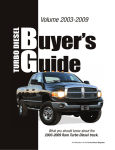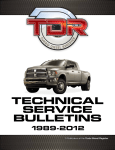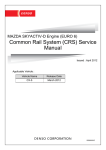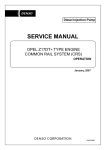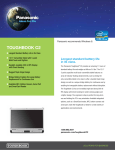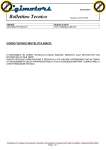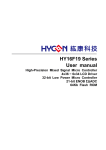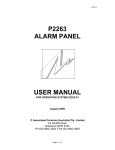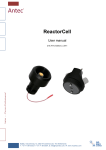Download Dodge 2008 DH Ram Technical information
Transcript
NUMBER: GROUP: DATE: 11-001-08 Exhaust May 21, 2008 This bulletin is supplied as technical information only and is not an authorization for repair. No part of this publication may be reproduced, stored in a retrieval system, or transmitted, in any form or by any means, electronic, mechanical, photocopying, or otherwise, without written permission of Chrysler LLC. SUBJECT: 6.7L Turbocharger Cleaning Procedure OVERVIEW: This bulletin involves the cleaning of the turbocharger, using Cummins Engine Update Kit 10138-UPD, to address excess soot accumulation. The procedure cleans the internal components on the exhaust side of the turbocharger. MODELS: 2007 - 2008 (DH/D1) Ram Truck (2500 / 3500) NOTE: This bulletin applies to vehicles equipped with a Cummins 6.7L engine (sales code ETJ) SYMPTOM/CONDITION: The turbocharger may require cleaning due to excessive soot accumulation. DIAGNOSIS: 1. Set the parking brake. Start the vehicle engine. 2. Connect the StarSCAN® to the vehicle Diagnostic Link Connector (DLC). 3. From the “Home” screen on the StarSCAN® select: a. “ECU View” button. b. “PCM Powertrain Control Module” button. c. “View DTC's” button. 4. Record all Diagnostic Trouble Codes (DTC's) that are present in the Engine Control Module (ECM) / Powertrain Control Module (PCM). NOTE: It is IMPORTANT to record (capture) all DTC's present in the ECM / PCM prior to proceeding further with this diagnosis. NOTE: Refer to Service Bulletins (SB) 11-002-08 and to 11-002-07 for detailed Turbocharger, Engine and Exhaust Aftertreatment System repair procedures. Performing a complete repair when cleaning (or replacing) a turbocharger includes thorough cleaning and/or inspection of several other Engine and Exhaust Aftertreatment System components. The Engine and Exhaust Aftertreatment Systems must be cleaned so that the systems operate as if in a “LIKE NEW” condition. DO NOT omit a component or step in the cleaning process. 11-001-08 -2- 5. Is DTC P1451, P2463, or P242F present in the PCM? a. If YES >>> then refer to Service Bulletin (SB) 11-002-07 (or later bulletin) to address this concern and before proceeding further with this Service Bulletin. In addition to other repairs, SB 11-002-07 (or later bulletin) may direct the technician to perform a thorough Engine and Exhaust Aftertreatment System cleaning and a mobile regeneration. Proceed to the next step ONLY after SB 11-002-07 has been reviewed. b. If NO >>> then proceed to the next step. 6. Is DTC P2262 present in the PCM? a. If YES >>> then refer to Service Bulletin (SB) 11-002-08 (or later bulletin) before proceeding. In addition to other repairs, SB 11-002-08 (or later bulletin) may direct the technician to perform a thorough Engine and Exhaust Aftertreatment System cleaning (including the cleaning of the turbocharger that is addressed in this Service Bulletin). Proceed to the next step ONLY after SB 11-002-08 has been reviewed. b. If NO >>> then STOP. This bulletin does not apply. 7. Only when all DTC's have been recorded, then verify that the ECM / PCM is at the latest application software level. 8. Is the ECM at the latest application software level? a. If YES >>> then proceed to the Repair Procedure. b. If NO >>> then reprogram the ECM / PCM to the latest software level, then proceed to the Repair Procedure. The warranty expense for reprogramming the ECM / PCM is not included in this Service Bulletin (SB). Check for any related Service Bulletins, such as SB 18-013-08 (or later bulletin). PARTS REQUIRED: Qty. Part No. Description 3 68044565AA Cleaner, Diesel Turbocharger (water base) 1 68050416AA Plug, Turbocharger Cleaning Port (stainless steel) (AR) 2 05019845AA Plug, Exhaust Oxygen Sensor w/metal gasket. (NOTE: Plug and Gasket are necessary for repair, but can be reused) (AR) 1 Special Tool 10143-4 Drill Bit and Stop (Replace drill bit only when worn, as required. Use only special drill bit for this repair) (AR) 1 Special Tool 10143-5 Tap and Stop (Replace tap only when worn, as required. Use only special tap for this repair) (AR) 2 05149063AA Sensor, Oxygen (NOTE: Not required for repair unless damaged) SPECIAL TOOLS/EQUIPMENT REQUIRED: 10138-UPD Cummins Engine Update Kit - includes kits 10142 & 10143 10142 Turbocharger Cleaning Kit 10143 Turbocharger Drill/Tap Kit (NOTE: Only use special tool drill bit #10143-4 and tap #10143-5 to perform the Repair Procedure - Order replacement drill and tap as required.) -3NPN Shop Vacuum with a Crevice Attachment NPN Pencil Magnet 11-001-08 NOTE: The spray nozzle in the Turbocharger Cleaning Kit uses a very small orifice for the cleaner to pass through. The design of the nozzle is important for the proper application of the chemical. If the orifice in the spray nozzle becomes restricted, carefully inspect and clean the filtering screen at the entrance to the nozzle of any debris. If careful, the nozzle may be disassembled for cleaning, should this be needed. REPAIR PROCEDURE: SECTION A - DETERMINE IF TURBOCHARGER HAS A CLEANING PORT: 1. Inspect the engine turbocharger to determine if the turbocharger is equipped with a cleaning port (Fig. 1). 2. Does the turbocharger have a cleaning port? a. If YES >>> then proceed to: SECTION C - TURBOCHARGER CLEANING PROCEDURE b. If NO >>> then proceed to: SECTION B - INSTALL A TURBOCHARGER CLEANING PORT Fig. 1 TURBOCHARGER CLEANING PORT 1 - TURBOCHARGER SPEED SENSOR HARNESS 2 - TURBOCHARGER CLEANING PORT PLUG 3 - TURBOCHARGER 11-001-08 -4- SECTION B - INSTALL A TURBOCHARGER CLEANING PORT: WARNING:At no time should a combustible cleaner be used. To introduce a combustible cleaner to the engine and/or exhaust aftertreatment system may cause damage to those systems and possible personal injury. 1. At the air filter housing cover, disconnect the Mass Air Flow (MAF) and the Inlet Air Temperature / Pressure (TBAP) sensors electrical connectors from the engine harness (Fig. 2). 2. Remove the air filter housing cover and fresh air tube together as an assembly. Fig. 2 AIR CLEANER HOUSING 1 - AIR CLEANER HOUSING COVER 2 - MASS AIRFLOW (MAF) SENSOR 3 - INLET AIR TEMPERATURE / PRESSURE (TBAP) SENSOR 3. With the turbocharger actuator electrical connector connected, turn the vehicle ignition switch to “ON/RUN” position. DO NOT start the engine. 4. Disconnect the turbocharger actuator electrical connector from the engine harness (Fig. 3). 5. Turn the vehicle ignition switch to the “OFF” position. 6. Disconnect and isolate negative battery cables on each battery. CAUTION: Performing the above steps now will become very important later in this procedure. The above steps should not be overlooked. The above steps will insure that the nozzle ring inside the turbocharger is moved so that it will not come in contact with the drill bit or tap. Failure to perform the above steps may damage the turbocharger mechanism. -5- 11-001-08 Fig. 3 6.7L TURBOCHARGER ACTUATOR 1 - TURBOCHARGER ACTUATOR ELECTRICAL CONNECTOR 2 - TURBOCHARGER ACTUATOR 3 - MOUNTING BOLTS 4 - TURBOCHARGER 7. Locate the Closed Crankcase Ventilation (CCV) tube hold down cap screw on the steel section of the CCV tube. Remove the CCV tube hold down cap screw. 8. Rotate the CCV tube upward and out of the way of the turbocharger. 9. Locate the turbocharger speed sensor that is mounted on top of the center section (bearing housing) of the turbocharger housing. NOTE: Clean the area of any dirt and/or debris that may be around the turbocharger speed sensor prior to removal. 10. Remove the turbocharger speed sensor attaching bolt. The bolt will be used later to hold in place the drill/tap guide of special tool Turbocharger Drill/Tap Kit (Fig. 4). 11-001-08 -6- Fig. 4 TURBOCHARGER SPEED SENSOR 1 - ATTACHING BOLT 2 - TURBOCHARGER SPEED SENSOR 11. Remove the turbocharger speed sensor. Verify that the speed sensor o-ring remains with the speed sensor and does not remain in the turbocharger center section / bearing housing. Fig. 5 DRILL AND TAP GUIDE 1 - DRILLING AND TAPPING GUIDE 2 - TURBOCHARGER -7- 11-001-08 12. Install the drill/tap guide into the turbocharger center section / bearing housing (Fig. 5). Secure the drill/tap guide in place with the previously removed turbocharger speed sensor attaching bolt. Tighten bolt to 10 Nm (89 in. lbs.). NOTE: There are two different size guide bushings that come with the drill/tap guide. The guide bushing with the smaller inner diameter center bore is used for guiding the drill bit. The guide bushing with the larger inner diameter center bore is used to guide the tap. 13. Install and secure the guide bushing with the small diameter bore hole (drill bit guide bushing) into the drill/tap guide bore. NOTE: Only use special tool drill bits #10143-4 and taps #10143-5 supplied in the Turbocharger Drill/Tap Kit #10143 to perform this Repair Procedure. CAUTION: ALWAYS check the drill stop to see if it is set correctly. It should be 42 mm (1 5/8 in.) from drill bit tip to bottom surface of the stop. VERIFY that the drill stop is set to the correct depth. VERIFY that the stop set screws are fully tightened. DO NOT over drill the hole. 14. Obtain a shop vacuum with a crevice attachment end to collect drill bit fillings. Make certain that the crevice tool is held as close as possible to the drill tip when drilling, and to the tap tip when taping the drilled hole. A small amount of filings that may enter into the drilled hole is acceptable. NOTE: DO NOT use any machining oil or other lubrication oil during the drilling and tapping operation. Use of machining oil or other lubricating oil may increase the number of drill and tap shavings introduced into the turbocharger, potentially leading to turbocharger mechanism failure. 11-001-08 -8- Fig. 6 DRILLING CLEANING PORT 1 - DRILL - USE LOW / SLOW SPEED WHEN DRILLING - DO NOT OVER DRILL HOLE. - MAXIMUM DEPTH IS 42 MM OR 1 5/8 INCHES 2 - DRILL AND TAPPING GUIDE 3 - TURBOCHARGER 15. Using a drill on SLOW speed, and the shop vacuum to collect filings, drill a hole through the turbocharger center housing casting to the correct depth. Continue to drill until the drill stop just makes contact with the turbocharger housing (Fig. 6). 16. Remove the drill bit from the drill/tap guide. Remove the drill guide bushing from the drill/tap guide. First, vacuum any excess metal filings. Next, using a pencil magnet with a magnetic tip smaller than the drilled hole, insert the magnet through the drilled hole and remove shavings as possible. DO NOT use the magnet during the process of drilling and taping as this would cause the drill/tap fixture and the turbocharger housing to become magnetized. 17. Install and secure the guide bushing with the larger diameter guide bore (tap guide bushing) into the drill/tap guide bore. NOTE: Only use special tool drill bits #10143-4 and taps #10143-5 supplied in the Turbocharger Drill/Tap Kit #10143 to perform this Repair Procedure. CAUTION: ALWAYS check the tap stop to see if it is set correctly. It should be 39 mm (1 9/16 in.) from tap tip to bottom surface of the stop. VERIFY that the tap stop is set to the correct depth. VERIFY that the stop set screws are fully tightened. DO NOT over tap the hole. 18. Install the tap into the tap bushing bore of the drill/tap guide. -9- 11-001-08 19. Install the tap handle to the drive end of the tap. If additional clearance is desired, install the female end of a 3 inch or 6 inch long 1/4 inch drive socket extension to the tap and then install the male end of the 1/4 inch extension to the tap handle. Fig. 7 TAPPING CLEANING PORT 1 - THREAD TAP AND TAP HANDLE (A 1/4 IN. DRIVE EXTENSION MAY BE ADDED FOR BETTER CLEARANCE) 2 - TURBOCHARGER 3 - DRILL AND TAP GUIDE - DO NOT OVER TAP HOLE - MAXIMUM DEPTH IS 39 MM OR 1 9/16 INCHES NOTE: DO NOT use any machining oil or other lubrication oil during the drilling and tapping operation. Use of machining oil or other lubricating oil may increase the number of drill and tap shavings introduced into the turbocharger, potentially leading to turbocharger mechanism failure. 20. Using the tap and tap handle, and with the shop vacuum to collect filings, tap the previously drilled hole made in the turbocharger center housing casting approximately 11 ½ turns (Fig. 7). This should be just about when turbocharger housing just touches the bottom of the tap stop. DO NOT OVER TAP THE HOLE. NOTE: DO NOT OVER TAP THE DRILLED HOLE. ONCE ENGAGED IN THE HOLE THREAD, THE TAP SHOULD TRAVEL NO MORE THAN APPROXIMATELY 11 1/2 TURNS (ABOUT 39 MM) INTO THE TURBOCHARGER CENTER HOUSING OR UNTIL IT JUST STARTS TO TOUCH THE TAP STOP. OVER TAPPING THE HOLE MAY FORCE / CAUSE THE TAP STOP TO SLIDE UP THE TAP. 11-001-08 -10- 21. Remove the tap from the drill/tap guide. Remove the tap bushing from the drill/tap guide. First, vacuum any excess metal filings. Next, using a pencil magnet with a magnetic tip smaller than the drilled hole, insert the magnet through the drilled hole and remove shavings as possible. DO NOT use the magnet during the process of drilling and taping as this would cause the drill/tap fixture and the turbocharger housing to become magnetized. 22. Remove the drill/tap guide from the turbocharger center housing. First, vacuum any excess metal filings. Next, using a pencil magnet with a magnetic tip smaller than the drilled hole, insert the magnet through the drilled hole and remove shavings as possible. 23. Install the turbocharger speed sensor and attaching bolt to the turbocharger center housing. Tighten the attaching bolt to 10 Nm (89 in. lbs.) (Fig. 4). 24. Install the stainless steel turbocharger cleaning port plug into the cleaning port of the turbocharger. Tighten the plug to 10 Nm (89 in. lbs.). Verify correct fit before proceeding. NOTE: The use of the proper Mopar Turbocharger Cleaning Port plug is critical. Use of an unapproved plug of different material type and/or thread may cause damage to the turbocharger. 25. Connect the engine harness connector to the turbocharger actuator connector (Fig. 3). 26. Rotate the CCV tube into position and install the CCV tube cap screw. Tighten the cap screw to 10 Nm (89 in. lbs.). 27. Install the air filter housing cover and fresh air tube hose. Tighten the fresh air hose clamp to 4 Nm (35 in. lbs.). Verify that there is a good seal at each end of the air tube hose. 28. Connect the engine harness connectors to the MAF and the inlet air temperature / pressure (TBAP) sensor connectors (Fig. 2). 29. Connect the negative battery cable to each battery. 30. Start the vehicle engine and verify correct engine operation. 31. Turn off vehicle engine. Verify that the ignition switch is in the “OFF” position. -11- 11-001-08 SECTION C - TURBOCHARGER CLEANING PROCEDURE: WARNING:At no time should a combustible cleaner be used. To introduce a combustible cleaner to the engine and/or exhaust aftertreatment system may cause damage to those systems and possible personal injury. CAUTION: Use ONLY Mopar Diesel Turbocharger Cleaner to perform this repair. Mopar Diesel Turbocharger Cleaner is a specially made WATER BASED solvent. Use of a flammable, or any low temperature combustible liquid/solvent, may cause severe damage to the engine and exhaust aftertreatment system components. Introduction of a flammable liquid/solvent to the engine intake system may cause engine run away, engine damage, and possible personal injury. Fig. 8 O2 SENSOR LOCATION 1 - FRONT OXYGEN SENSOR 2 - REAR OXYGEN SENSOR 11-001-08 -12- CAUTION: The turbocharger, exhaust, and surrounding components are at high temperatures. Use the proper protection and care when working on or around the turbocharger and exhaust system. 1. Raise the vehicle on a suitable lift. 2. Remove both exhaust system oxygen sensors (Fig. 8). 3. Temporarily install an oxygen sensor plug into each empty oxygen sensor hole. Tighten plugs to 41 Nm (30 ft. lbs.). 4. Lower the vehicle. 5. Connect the vehicle tailpipe to the shop exhaust ventilation system. Turn the shop exhaust ventilation system ON. 6. Start the vehicle engine and allow to idle and warm. Using the StarSCAN scan tool: a. From the “HOME” menu, select “PCM”. b. Select “More Options”. c. Select “System Test”. d. Set engine speed to 2,100 RPM. e. Follow the prompts. f. Select “Actuate”. g. Monitor vehicle and engine temperature. 7. Locate the cleaning tool (hose) and nozzle from the Turbocharger Cleaning Kit special tool. 8. Continue to run the vehicle engine until engine temperature is at 82C (180F) or higher. NOTE: The vehicle engine must be fully warmed (82C/180F or higher) so that the turbocharger and accumulated soot are at the correct higher temperatures for this repair to be effective. The exhaust side of the turbocharger will be significantly higher in temperature than the 82C/180F engine operating temperature. 9. Stop the vehicle engine and remove the turbocharger cleaning port access plug (Fig. 1). -13- 11-001-08 Fig. 9 CLEANING NOZZLE INSTALLED 1 - CLEANING TOOL NOZZLE 2 - CLEANING TOOL HOSE - ROUTE AWAY FROM BATTERY TERMINALS 3 - TURBOCHARGER 10. Install the nozzle of the turbocharger cleaning tool into the turbocharger cleaning port tapped hole (Fig. 9). Use care not to cross-thread the tapped hole. Tighten nozzle to 5.6 Nm (50 in. lbs.). NOTE: The spray nozzle in the Turbocharger Cleaning Kit uses a very small orifice for the cleaner to pass through. The design of the nozzle is important for the proper application of the chemical. If the orifice in the spray nozzle becomes restricted, carefully inspect and clean the filtering screen at the entrance to the nozzle of any debris. If careful, the nozzle may be partially disassembled for cleaning, should this be needed. 11. Place a fender cover over the top of the right battery to isolate / insulate the battery terminal ends from the cleaning tool hose. 12. Install the hose of the turbocharger cleaning tool to the other end of the cleaning nozzle. 11-001-08 -14- Fig. 10 CLEANING TOOL HOSE ROUTING 1 - TURBOCHARGER WATER BASE CHEMICAL CLEANER - HOLD CAN BOTTOM UP TO DISPENSE 2 - BATTERY - USE A FENDER COVER TO ISOLATE BATTERY TERMINALS FROM CLEANING TOOL HOSE 3 - EGR COOLER BY-PASS VALVE ASSEMBLY CABLE HOUSING SLEEVES - ROUTE CLEANING TOOL HOSE UNDER SLEEVE LOOP TO KEEP CLEANING TOOL HOSE AWAY FROM BATTERY TERMINALS 4 - TURBOCHARGER CLEANING TOOL HOSE - ROUTE AWAY FROM BATTERY TERMINALS 13. Route the tap end of the cleaning tool hose under both cable sleeves of the EGR Cooler By-Pass Valve Assembly so that the cleaning tool hose is held away from the positive battery terminal by the throttle body cable sleeves (Fig. 10). 14. Verify that the turbocharger cleaning tool tap cutoff valve is in the CLOSED position. 15. Start the vehicle engine and allow to idle. Verify that the engine temperature is at 82C (180F) operating temperature. -15- 11-001-08 Fig. 11 CLEANING CHEMICAL AND TOOL 1 - TURBOCHARGER WATER BASE CHEMICAL CLEANER - USE ONLY A WATER BASE CHEMICAL 2 - CLEANING TOOL HOSE - ROUTE AWAY FROM BATTERY TERMINALS 3 - CLEANING TOOL CAN TAP VALVE - SHOWN IN “OPEN” POSITION 16. Install a can of the Diesel Turbocharger Cleaner to the turbocharger cleaning tool tap (Fig. 11). 17. Hold the Diesel Turbocharger Cleaner can UPSIDE DOWN (can nozzle is to point towards the ground). NOTE: To dispense the full contents of the cleaner correctly, the Diesel Turbocharger Cleaner can must be UPSIDE DOWN (can nozzle pointing towards the ground). It is preferred that the Diesel Turbocharger Cleaner can be higher than the level of the turbocharger while the cleaner is being dispensed. 18. Fully OPEN the turbocharger cleaning tool can tap cutoff valve and dispense the entire contents of the turbocharger cleaner. This may take approximately 5 minutes. 19. CLOSE the turbocharger cleaning tool can tap cutoff valve. 20. Stop the vehicle engine. Turn the vehicle ignition switch to the “OFF” position. 21. WITHOUT STARTING THE VEHICLE ENGINE, cycle the ignition switch 10 times from the “OFF” position to the “RUN/ON” position and back to the “OFF” position. WAIT 4 SECONDS between each full key cycle of the ignition switch. 22. Repeat steps 14 - 21 two (2) additional times. Each time dispensing a new can of the Diesel Turbocharger Cleaner. 23. After all three (3) cans of the Diesel Turbocharger cleaner have been dispensed, remove the turbocharger cleaning tool from the cleaning tool nozzle. 24. Remove the cleaning tool nozzle from the housing of the turbocharger. 25. Install the stainless steel turbocharger cleaning port plug into the cleaning port of the turbocharger. Tighten the plug to 10 Nm (89 in. lbs.). 11-001-08 -16- NOTE: The use of the proper Mopar plug is critical. Use of an unapproved plug of different material type and/or thread may cause damage to the turbocharger. 26. 27. 28. 29. Remove the protective fender cover from the right battery. Raise the vehicle. Remove both oxygen sensor plugs from the exhaust system. CLEAN BOTH OXYGEN SENSORS using a clean cloth and compressed air. Do not use any type of liquid cleaner to clean the oxygen sensor tips. Use compressed air to remove all soot from the oxygen sensor tip that is inside (under) the metal shield/cover. Blow compressed air into the center hole of the sensor shield to remove soot from the sensor tip. Ensure all soot has been removed from the sensor tip (inside the shield) and on the outside of the sensor tip shield (Fig. 12). Fig. 12 O2 SENSOR CLEANING 1 - CENTER HOLE - BLOW COMPRESSED AIR THROUGH HOLE TO DISLODGE SOOT ON SENSOR - CLEAN THOROUGHLY 2 - THREADS - INSPECT FOR DAMAGE - APPLY A SMALL AMOUNT OF ANTI-SEIZE TO THREADS 30. Install the oxygen sensors to the exhaust system (Fig. 8). Tighten both oxygen sensors to 41 Nm (30 ft. lbs.). 31. Lower the vehicle. 32. Using a scan tool, clear all fault codes. NOTE: Once this Service Bulletin has been completed, refer to Service Bulletins 11-002-08 and 11-002-07 for detailed Turbocharger, Engine, and Exhaust Aftertreatment System repair procedures. Performing a complete repair when cleaning (or replacing) a turbocharger includes a thorough cleaning and/or inspection of several other Engine and Exhaust Aftertreatment System components. The Engine and Exhaust Aftertreatment Systems must be cleaned so that the systems operate as if in a “LIKE NEW” condition. DO NOT omit a component or step in the cleaning process. -17- 11-001-08 POLICY: Reimbursable within the provisions of the warranty. TIME ALLOWANCE: Labor Operation No: Description Amount 09-44-01-93 Turbocharger, Install Cleaning Port and Clean (B) 2.1 Hrs. 09-44-01-94 Turbocharger, Clean (B) FAILURE CODE: ZZ Service Action 1.5 Hrs.

















